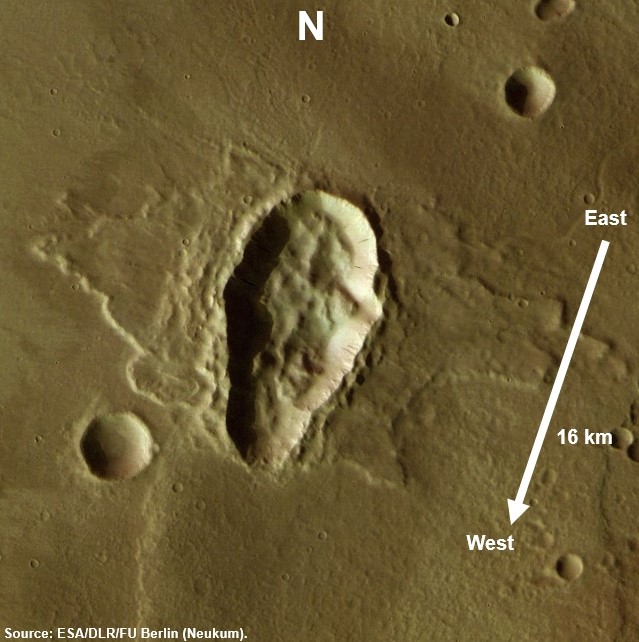Analysis of topographic profiles of elongated craters on Mars
- 1Space Analytics, Germany (bernd@spaceanalytics.org)
- 2Research and Scientific Support Department of ESA, ESTEC, Noordwijk, The Netherlands
Abstract
The elongated crater population on Mars is of great interest in planetary sciences [1]. In 1982, 1988 and 2000 three datasets were established using Viking images [1,2,3]. In 2011 a new and improved set of data with 261 craters and a database including up-to-date images taken by the High Resolution Stereo Camera (HRSC) onboard ESA’s Mars Express were established [4] and continuously updated [5]. Based on the crater shape [6] and the ejecta deposit [7] the direction of impact can be estimated. Since this is not always a straightforward determination, it was decided to check whether the topographic profile could help in ambiguous cases.
1. Introduction
Impact cratering is one of the fundamental processes in shaping the surface of terrestrial planets. Even though most impact structures have a circular shape, a small fraction of elongated craters formed by oblique impacts can be observed. Using the recently developed Mars Express database, the current study focuses on the impact direction of elongated craters on Mars.
2. Motivation for the study
One major driver for conducting this study is the ongoing discussion of the decaying moonlets hypothesis, which might be an explanation for at least a fraction of the elongated crater population on Mars, as well as the unsolved origin of the Martian moons, Phobos and Deimos [5,9].
3. Direction of impact
As a precondition the crater orientation is analysed and a strong correlation to the crater age can be stated. For the identification of the impact direction a two-stage process is applied and this presentation shows the usefulness of the procedure. A first estimation is based on the crater shape [6] and the ejecta deposit [7]. Figure 1 shows a crater example and table 1 the summarized results for the elongated crater population on Mars. Subsequently, the estimation is reviewed by an analysis of the topographic crater profiles, which result from the pressure distribution during impact [8]. Figure 2 presents the corresponding profile for the first example crater. This review process indicates the validation of the results of the first stage. For craters with morphological characteristics not allowing a distinct identification of the impact direction in stage one this approach helps to improve the dataset dramatically (figures 3 and 4).
4. Figures
Figure 1: Estimation of impact direction based on crater shape and ejecta deposit for example crater 1

Figure 2: Altitude profile of example 1 based on HRSC MOLA blended DEM (200m) confirms East to West impact direction
Figure 3: Distinct identification of impact direction based on crater shape and ejecta deposit difficult for example crater 2
Figure 4: Altitude profile indicates West to East impact direction
5. Table
Table 1: Direction of impact
Acknowledgements
B. Buchenberger sincerely thanks O. Witasse for more than a decade of great cooperation and friendship that gave him the opportunity to work on such wonderful topics like this.
References
[1] Schultz, P. H. and Lutz-Garihan, A. B.: Grazing Impacts on Mars: A Record of Lost Satellites, Journal of Geophysical Research, Vol. 87, p. 84-96, 1982.
[2] Barlow, N. G.: Crater Size-Frequency Distributions and a Revised Martian Relative Chronology, Icarus, Vol. 75, p. 285-305, 1988.
[3] Bottke, W. F., Love, S. G. et al.: Interpreting the Elliptical Crater Populations on Mars, Venus and the Moon, Icarus, Vol. 145, p. 108-121, 2000.
[4] Buchenberger, B., Witasse, O. et al.: Elongated craters on Mars revisited: Test of the decaying moonlets hypothesis? EPSC-DPS Joint Meeting, p. 738, 2011.
[5] Sefton-Nash, E., Faes, Z. et al.: The Orbit Planes of Impactors that Formed Elongated Martian Craters, EPSC, p.286, 2017.
[6] Burchell, M.J., Robin-Williams, R. et al.: The SMART-1 lunar impact, Icarus, Vol. 207, p. 28-38, 2010.
[7] Melosh, H.J.: Impact Cratering - A Geologic Process, Oxford University Press, New York, p. 101, 1996.
[8] Pierazzo, E. and Melosh, H. J.: Melt Production in Oblique Impacts, Icarus, Vol. 145, p. 252-261, 2000.
[9] Craddock, R.A.: Are Phobos and Deimos the result of a giant impact? Icarus, Vol. 211, Iss. 2, p. 1150, 2011.
How to cite: Buchenberger, B., Sefton-Nash, E., and Witasse, O.: Analysis of topographic profiles of elongated craters on Mars, European Planetary Science Congress 2021, online, 13–24 Sep 2021, EPSC2021-492, https://doi.org/10.5194/epsc2021-492, 2021.

